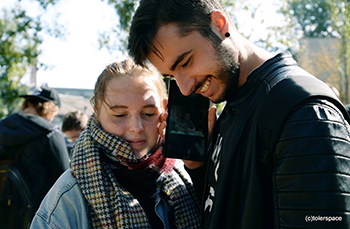
Sasha Yemelianova
Sasha Yemelianova has learned about the Babi Yar massacre in school before, but going on USC Shoah Foundation’s IWalk and leading it for other students has given her a new perspective of the massacre and its memorialization.
German and SS police units murdered nearly the entire Jewish population of Kiev – 33,771 men, women and children – at the Babi Yar ravine outside the city on September 29 and 30, 1941. About 75,000 more Jews as well as communists, Roma, and Soviet prisoners of war were also murdered there over the next few months.
On the Babi Yar IWalk, students tour the historic site of the Babi Yar massacres, stopping along the way to watch clips of Holocaust survivors’ testimonies about Babi Yar from the Visual History Archive on tablet devices. The clips cover the history of Babi Yar, pre-war and occupied Kiev, the killings, stories of survival, commemoration and denial.
USC Shoah Foundation debuted the IWalk on the 70th annivserary last year.
As with last year, student “peer guides” trained by the Institute led local school groups on the IWalk through Babi Yar during the week of this year’s anniversary.
Sasha is a student at Kyiv-Mohyla Academy. She learned about the IWalk program from a friend who participated last year, and when she had the opportunity to try it out for herself, she was impressed by the testimonies and the experience of watching the clips while touring the historic location.
When Sasha led an IWalk for the first time last week, the students she was leading were not immediately engaged, she said. She and her fellow guides worked hard to capture their interest and help them empathize with the testimonies they watched.
Sasha said for her, the testimonies are shocking, and they inspire feelings and emotions she doesn’t often experience in her everyday life.
“Childen have an opportunity to think and memorialize what they have just heard,” Yemelianova said. “I am confident that they will share their feelings and the knowledge that was left after our IWalk, because it is impossible to keep silent after hearing those testimonies.”
The interactive format of the IWalk is ideal for teenagers and young people because it enables them to think critically, to ask “Why?” and to have a discussion about what they have learned, not just memorize facts from a textbook, Sasha said.
“Teenagers not only learn from a guide what has happened, but they participate themselves by watching video testimonies and working with quotes,” she said. “They have a chance to walk those streets, and dive, though shortly, into the atmosphere of what people have experienced there.”